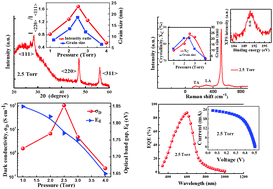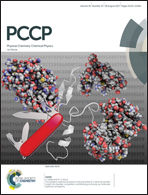Development of optimum p-nc-Si window layers for nc-Si solar cells
Abstract
p-Type nc-Si (p-nc-Si) films have been optimized under low growth temperature (∼180 °C) and low power (∼30 W) parametric conditions in 13.56 MHz RF-PECVD. At elevated gas pressure (p), the growth rate enhances; however, the optical band gap reduces. At optimum p = 2.5 Torr, a p-nc-Si window-layer possessing high crystallinity, large grain size, high electrical conductivity, wide optical band gap and a preferred 〈220〉 crystallographic orientation of the nanocrystallites is obtained. Single p–i–n junction nc-Si solar cells in superstrate configuration have been realized with reasonably acceptable conversion efficiency, η ∼ 7.05%. The preferred 〈220〉 oriented (I〈220〉/I〈111〉 ∼ 1.68) highly crystalline (XC ∼ 86%) p-nc-Si window-layer minimizes the lattice mismatch at the p/i-junction, facilitates the growth of proper crystallinity in the i-nc-Si absorber layer from its incubation stage during its sequential growth over the window layer and ensures low recombination losses for conduction of charge carriers along the vertical direction at the p/i-interface. Further improvement in cell efficiency sensitively depends on proper optimization and future ungradation of the i-nc-Si absorber layer, and the single junction nc-Si cell could play a significant role as an integral part of premium all-Si tandem structure solar cells.

- This article is part of the themed collection: 2017 PCCP HOT Articles


 Please wait while we load your content...
Please wait while we load your content...